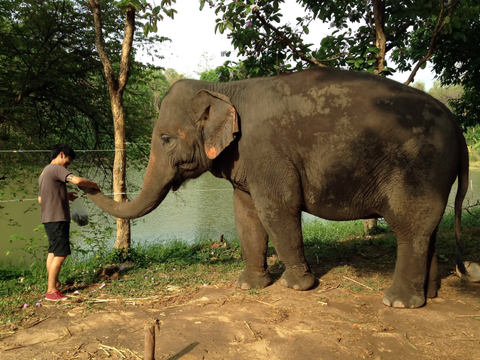
All About Elephants – Facts and Figures

The elephant, the largest of all land mammals, has evolved over 60 million years. The first ancestor of modern elephants was called Moeritherium after the place where it was discovered, the Moeris Lake in Egypt.Moeritherium were a pig-like shape, about the size of a tapir with a short tail and no trunk or tusks, but fangs and they lived an amphibian life, like a hippopotamus. Among many minor similarities, scientists base Moeritherium’s ancestry of the elephant on two important common features: its skull (the skull had air holes just like an elephant) and fangs (small tusks that grew up from the lower jaw).
After Moeritherium the order of Proboscidea developed different members all with the common characteristics of skull and teeth. Some early Proboscidea had two pairs of tusks, growing from both the upper and lower jaws. Nearly all the first Proboscideans inhabited the African continent, until the beginning of the Miocene Period (about 26 million years ago), when they migrated all over the world, with the exception of Australia and Antarctica.

How many different kinds of elephant are there?
During the Miocene Period, between 26 and 12 million years ago, the Proboscideans increased in diversity as they spread around the planet, until there were some 350 distinct species. What happened to all of them after that we cannot be sure, but by the end of the Holocene Period around 10,000 years ago, only two species remained: African Elephants (known as Loxodonta Africana) and Asian (Elephas maximus).
"…between 26 and 12 million years ago…there were some 350 distinct species…now only two species remain: African Elephants and Asian Elephants.”
African elephants fall into two types: the gray colored Savannah (Loxodonta Africana Africana) and dark gray colored Forest (Loxodonta Africana Cyclotis). The Savannah elephants are much larger than the Forest and they are the largest of all the species, with the males growing up to four meters in height and seven tons in weight.
Asian elephants fall into three types: the gray and pigmented Sri Lankan (Elephas Maximus Maximus), the lighter gray Mainland elephant (Elephas Maximus Indicus) and very light gray Sumatran (Elephas Maximus Sumatranus).
The main differences between the two species are as follows:
African: elongated skull, a trunk with deep rings, larger ears, a flat forehead and generally holds its head at a 45 degree angle to the ground. Both males and females have tusks. Wilder and less intelligent than the Asian elephant. Their habitat covers the continent of Africa, especially the part south of the Sahara Desert.
Asian: an enormous double-bulged forehead, a trunk with fewer rings, smaller ears and a skull with a 90-degree orientation. Only males have tusks and some only small or none at all. Intelligent with a good memory and easy to train. They are found in Sri Lanka, India, Nepal, Bhutan, Bangladesh, Burma, Thailand, Laos, Cambodia, Vietnam, Malaysia and Indonesia (on Sumatra and Borneo).
Endangered and Abused
The sad fact is that despite their 60 million year ancestry and at their peak of about 350 species, the elephant population has been decreasing so tremendously that they are now considered to be an endangered species. African elephants are relatively safe, with estimated numbers as many as 500,000, whereas there are probably no more than 30,000 Asian elephants left on this planet.
One hundred years ago there were about 100,000 Thai elephants. Today there are fewer than 4,000 elephants in the entire kingdom – 2,000 of which are in the wild and 2,000 are domesticated – and unless strong conservation measures are taken the Thai elephant is in grave danger of becoming extinct.
…unless strong conservation measures are taken the Thai elephant is in grave danger of becoming extinct.”
In Thailand, the elephant is esteemed above all other animals, but this does not ensure their protection or prevent abuse. It is not unusual to encounter domestic elephants and their mahouts walking the traffic filled streets of Bangkok, Chiang Mai and other major cities begging for food and cash. Needless to say, this is not their natural habitat and they quickly succumb to stress and diseases related to poor and inadequate diet.
Tourists will often find baby elephants at resorts and entertainment complexes where they are used as showpieces. A baby elephant is totally dependent on its mother for at least four years – in fact weaning takes place for ten years in normal conditions – and if it is taken away sooner it will not learn how to cope by itself, will suffer from malnutrition, loneliness, stress and disease and will inevitably die young.
The vital process of elephant conservation is not as effective as it should be. Many problems face Thai elephants and there is little time left to procrastinate or we will lose them forever.
Interesting Facts About Elephants
Brain: When compared to its weight the elephant’s brain is relatively small and smaller than a human brain, yet it is the largest of all land mammals. Large areas are devoted to memory and scent. Plenty of curves and notches in the brain indicate high intelligence and a capacity for learning greater than many animals.
Teeth: Elephants have six or seven new sets of four grinding teeth during a lifetime. These teeth are huge by any standard, weighing about 4kg each and are about 30cm long! When the last of these teeth wear out, the elephant will die because it will starve to death. Tusks are an elephant’s incisor teeth, which grow from the upper jaw and become visible when an elephant is 2-5 years old.
Eyes: Elephants have small eyes when compared to their large size, yet they can see things clearly at a considerable distance.
Trunk: The trunk is an incredible organ with multiple uses. There are no bones in the trunk but it contains 40,000 muscle groups (compared to about 60,000 muscle groups in the entire body of a human being). This flexibility enables the elephant to have very sensitive touch, which of course is perfect for painting. The elephant can use its trunk to pick up tiny objects as well as weights up to 100 kg, use it as a pipe for sucking water (an adult can hold 10 litres) and dirt, as a ‘radar’ by blind elephants, for smelling, trumpeting (calling), for throwing things and it is used as a powerful weapon for fighting, to grab a smaller opponent (before stamping on it or stabbing with its tusks). Interestingly, the trunk is not used for drinking, but as a tool for sucking up water and then blowing into the mouth.
Some Things You May Not Have Known About Elephants
- Elephants sweat only at their toenails.
- An Asian elephant has five toes on the front feet and four on the back.
- Asian elephants have ears about 30 x 60cm, one third the size of African elephants.
- Elephants have very advanced listening capabilities and can communicate over vast distances (as far as 4 km in normal conditions) using infrasound, sound waves which humans are incapable of hearing.
- An elephant smells by placing the tip of its trunk inside its mouth after touching an object.
- Elephants can stay afloat for a long time and swim well.
- Elephants can walk or swim under water, using their trunk as a snorkel.
- Elephants have a special pouch in their throat from which they can suck out water with their trunk to use as a cooling spray.
- Elephants live to about 55 to 60 years old, though the oldest known is 82 years.
- Elephants have a prime working age of 25 years and a “retirement” age of about 50.
- Elephants can run up to 20km an hour.
- Elephants cannot walk over 12km per hour.
- Elephants sleep 3-5 hours a night.
- Elephant society is matriarchal, with a senior female as head of the group.
- While females form a close knit bond with each other and their collective offspring, males tend to be nomadic, forming bands with other males that join the female herds only for mating.
- Females become fertile at age 15-16 up to 50 years old.
- Females can give birth to as many as 11-12 calves during their lifetime.
- Male elephants reach puberty at about age 14 years.
- Elephants will mate whenever she is receptive, but she is most often fertile in the hot season and only for a few days.
- Pregnancy lasts 17.5 -24 months, with male infants (21 – 24 months) taking slightly longer than females (17.5 – 23 months).
- A newborn baby elephant weighs 80-100kg and will stand up and be able to walk within two hours.
- A newborn baby may drink more than 10 litersof mother’s milk a day.
- Elephants are pure vegetarians, eating mostly leaves and grasses, but they also love sugar cane, bamboo shoots and ripe fruit, especially bananas and mangoes.
- Elephants drink about 200 liters(90 gallons) of water a day.
- Elephants eat about 250kg of food a day.
